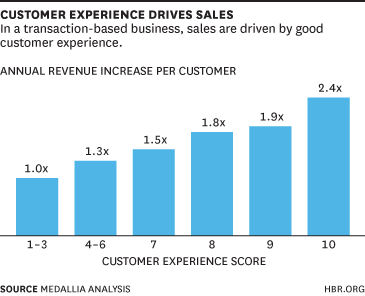
Sales and customer service are (secretly) the same thing.
Since 2017, we’ve worked on dozens of sales copywriting projects. From engaging email marketing to lead magnets and sales pages, we’ve been applying customer service thinking to optimising for conversions.
In this short article, I’ll demystify “sales through service” by showing 5 ways that service and sales support each other (or even fuse). Ultimately, I hope to contribute to a view of customer service as a profit centre, not a cost centre — and a better experience for all customers.
1. Both sales and customer service want to optimise customer lifetime value (CLV)
Why offer customer support at all? At the most basic level, to keep customers.
The maths is simple: Keeping a customer = selling to them repeatedly and making more money.
If we define a customer as someone who buys repeatedly from a business, service and sales feed into each other. This is perhaps most visible in some Software-as-a-Service (SaaS) businesses, where customer success managers support their customers strategically, while also managing the relationship in commercial terms.
A focus on retention pays off:
The probability of selling to a new prospect is 5-20%. The probability of selling to an existing customer is 60-70%.
(Paul W. Farris, Neil T. Bendle, Phillip E. Pfeifer and David J. Reibstein (2010): Marketing Metrics: The Definitive Guide to Measuring Marketing Performance; emphasis mine.)
Not only is the probability higher:
Happy customers are also likely to spend much more.
Peter Kriss found that “customers who had the best past experiences spend 140% more compared to those who had the poorest past experience” (HBR, 1 August 2014):

The bottom line: By optimising your customer experience, you can make more than twice the revenue from the same number of customers.
2. Happy customers may be receptive to an upsell
Service teams often dislike the idea of “upselling”. Usually, that’s because they either feel under pressure to meet a certain target, or they approach the wrong customer in the wrong way – sometimes both.
Especially before the holidays, there’s always lots of talk about increasing “sales through service”. And while that sounds good, it’s dangerous to just make it a mantra, increase the service team’s sales targets and leave it at that. No wonder, then, that even my autocorrect keeps turning the word into “upsetting”!
The most important thing to remember: do not even try to upsell an unhappy customer.
That’s also why upselling messages are not ideal for the customer service phone queue, when people are still waiting to get their issue addressed. They’re not happy, and so they dismiss any upsell attempts and perhaps even come through to the team in a disgruntled mood. (Believe me, I wrote sales messages for phone IVR systems for years… it’s very difficult to optimise for conversions in that space.)
But once the problem is solved for the customer, and they’re relaxed — then the advisor can offer additional value, at a price.
Len Markidan from Groove explains how to do it well:
focusing on how you’re helping the existing customer win even more [= get even more benefit] is absolutely critical for upselling without being pushy.
(— Would you like a marshmallow with your hot chocolate?)
3. People are prepared to pay for (some) solutions to their queries
According to a 2010 study, almost 9 out of 10 U.S. consumers say they’d pay extra to get a superior customer experience (Customer Experience Impact Report by Harris Interactive/RightNow). The crowded Priority Boarding queues on cheap airlines seem to corroborate this.
Now, I’m not a fan of artificially hiding value behind a paywall. But if the majority of your customers have no need for an expensive feature, then it may be worth thinking about a paid premium option.
Same-day delivery, valet parking, hotel porters, boarding kennels with daily dog grooming sessions — these are all extras that improve the service, but not everyone needs them.
What premium solutions could your business offer?
4. Customer service insights can steer you towards more sales
Customer research may reveal that it’s worth opening a new shop in a particular location, or selling an existing product in more colours or sizes. Feature requests and questions about availability are highly visible to customer service teams, and companies that use those insights — for example, via a Voice of the Customer programme — may find ways to sell more.
Which leads us to my last — and most important — point:
5. “Customer service is an attitude, not a department”
Wait, isn’t this the number one platitude in customer service consulting?
Yes, until we consistently apply a service attitude to sales. Then, the two “departments” kinda fuse into one.
A focus on serving the customer often uncovers reasons why sales aren’t coming in as expected, and vice versa. Usually, problems with conversion occur because the sales copy doesn’t help the customer fix their problem. Fixing problems is, of course, a classic customer support skill. What is more, service teams usually know a lot about what kinds of problems customers want to fix.
The best value propositions don’t just rely on industry data and insider knowledge of a product or service. They’re based on customer-focused evidence.
Great conversion copywriters…
- take a look at customer service emails, tweets and chat messages, too
- listen to recorded customer support calls
- mine review sites to find out what people like and don’t like about competitors
- and importantly, they ask at least some customers directly about their struggles. They ask questions such as, “What are you struggling with [when you make your tea / during school run / when booking a meeting room/ other relevant scenario]?”
That bit can easily take longer than writing the copy itself. As Gregory Ciotti from Help Scout puts it, “a well-defined problem is half solved. But getting there is harder than you’d expect.”
Putting in the time and effort helps us find the customers’ “jobs to be done”
In Know Your Customers’ “Jobs to Be Done” (HBR, September 2017), Clayton M. Christensen, Taddy Hall, Karen Dillon and David S. Duncan explain the concept of “jobs to be done”:
We all have many jobs to be done in our lives. Some are little (pass the time while waiting in line); some are big (find a more fulfilling career). Some surface unpredictably (dress for an out-of-town business meeting after the airline lost my suitcase); some regularly (pack a healthful lunch for my daughter to take to school). When we buy a product, we essentially “hire” it to help us do a job. If it does the job well, the next time we’re confronted with the same job, we tend to hire that product again. And if it does a crummy job, we “fire” it and look for an alternative.
Claire Suellentrop explains how to define the customer’s problem and find their job to be done in Websites that Convert: The fundamentals of writing compelling website copy:
Open up everything you’ve collected, pour yourself a drink, and get ready to organize.
Here’s what you’re looking for as you read through your customer research:
• Pains that led someone to seek a new solution
• What people say they want (using phrases like I want, I wish, I need)
• The problems eliminated once they start using a new solution
• The benefits created by a new solution
• Things lacking in their old solution
• Things lacking in their new solution
• Most common words and phrases people use
• Especially interesting or “sticky” words and phrases people use
Once you’ve sorted your research into the categories above, review each category, and organize the messages in priority order: from the most-often-mentioned messages, to the least-often-mentioned messages. This will help you see which messages will resonate most strongly with your visitors.
Now it’s all about using the right words to have the right conversation with (potential) customers. Good copywriters find the balance between the customers’ exact words and carefully crafted messages to make sure the sales page (or brochure, or email) really hits home with people. You want potential customers to think, “Yes, that’s me — they can help me solve that issue and get the job done.”
We’re here to help
If you’d like any help with that research, or with finding those words: get in touch today and find out if we’re a good fit.